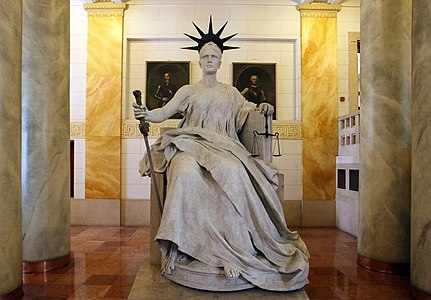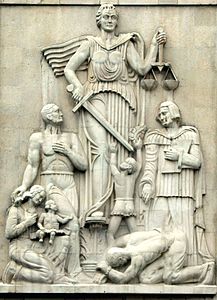Lady Justice

Lady Justice (Latin: Iustitia) is an allegorical personification of the moral force in judicial systems.[1][2] Her attributes are a blindfold, scales, and a sword. She often appears as a pair with Prudentia.
Lady Justice originates from the personification of Justice in Ancient Roman art known as Iustitia or Justitia,[3] who is equivalent to the Greek goddess Dike.
The goddess Justicia[]
The origin of Lady Justice was Justitia, the goddess of Justice within Roman mythology. Justitia was introduced by emperor Augustus, and was thus not a very old deity in the Roman pantheon.
Justice was one of the virtues celebrated by emperor Augustus in his clipeus virtutis, and a temple of Iustitia was established in Rome by emperor Tiberius.[3] Iustitia became a symbol for the virtue of justice with which every emperor wished to associate his regime; emperor Vespasian minted coins with the image of the goddess seated on a throne called Iustitia Augusta, and many emperors after him used the image of the goddess to proclaim themselves protectors of justice.[3]
Though formally called a goddess with her own temple and cult shrine in Rome, it appears that she was from the onset viewed more as an artistic symbolic personification rather than as an actual deity with religious significance.
Depiction[]
This section needs additional citations for verification. (March 2015) |

The personification of justice balancing the scales dates back to the goddess Maat,[4] and later Isis, of ancient Egypt. The Hellenic deities Themis and Dike were later goddesses of justice. Themis was the embodiment of divine order, law, and custom, in her aspect as the personification of the divine rightness of law.
Scales[]
Lady Justice is most often depicted with a set of scales typically suspended from one hand, upon which she measures the strengths of a case's support and opposition.
The Greek goddess Dike is depicted holding a set of scales.
Bacchylides, Fragment 5 (trans. Campbell, Vol. Greek Lyric IV) (Greek lyric c. 5th B.C.):
If some god had been holding level the balance of Dike (Justice).
The scales represent the weighing of evidence, and the scales lack a foundation in order to signify that evidence should stand on its own.
Blindfold[]

Since the 16th century, Lady Justice has often been depicted wearing a blindfold. The blindfold represents impartiality, the ideal that justice should be applied without regard to wealth, power, or other status. The earliest Roman coins depicted Justitia with the sword in one hand and the scale in the other, but with her eyes uncovered.[5] Justitia was only commonly represented as "blind" since the middle of the 16th century. The first known representation of blind Justice is Hans Gieng's 1543 statue on the Gerechtigkeitsbrunnen (Fountain of Justice) in Berne.[6]
Instead of using the Janus approach, many sculptures simply leave out the blindfold altogether. For example, atop the Old Bailey courthouse in London, a statue of Lady Justice stands without a blindfold;[7] the courthouse brochures explain that this is because Lady Justice was originally not blindfolded, and because her "maidenly form" is supposed to guarantee her impartiality which renders the blindfold redundant.[8] Another variation is to depict a blindfolded Lady Justice as a human scale, weighing competing claims in each hand. An example of this can be seen at the Shelby County Courthouse in Memphis, Tennessee.[9]
Sword[]
The sword represented authority in ancient times, and conveys the idea that justice can be swift and final.[10]
Toga[]
The Greco-Roman garment symbolizes the status of the philosophical attitude that embodies justice.[10][unreliable source?]
In computer systems[]
| ⚖ | |
|---|---|
Scales | |
| In Unicode | U+2696 ⚖ SCALES (HTML ⚖) |
| Related | |
| See also | U+00A7 § SECTION SIGN |
Unicode version 4.1.0 implemented a symbol at code point U+2696 that may be used to represent the scales of justice.[11]
In art[]
Sculpture[]

Lady Justice with sword, scales and blindfold on the Gerechtigkeitsbrunnen in Berne, Switzerland—1543

The Justice, in front of the Supreme Court of Brazil

Lady Justice seated at the entrance of The Palace of Justice, Rome, Italy
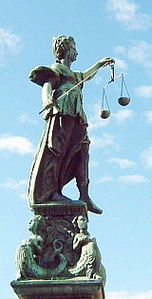
Sculpture of Lady Justice on the in Frankfurt, Germany

Justitia, outside the Supreme Court of Canada, Ottawa, Ontario, Canada

The Central Criminal Court or Old Bailey, London, UK

Themis, Itojyuku, Shibuya-ku, Japan
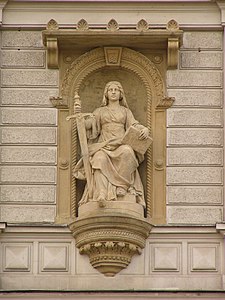
19th-century sculpture of the Power of Law at Olomouc, Czech Republic—lacks the blindfold and scales of Justice, replacing the latter with a book

Themis, Chuo University, Tama-shi, Japan

Themis, Chuo University Suginami high school, Suginami-ku, Japan

The Law, by Jean Feuchère
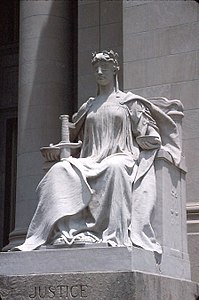
Shelby County Courthouse, Memphis, Tennessee, United States
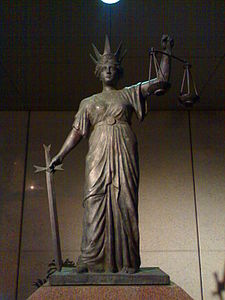
Themis, outside the Supreme Court of Queensland, Brisbane, Queensland, Australia

Themis, Old courthouse, Ghent, Belgium

, Carl Spitzweg, 1857
Painting[]

Fresco in the , Raphael Rooms, Raphael, c. 1520
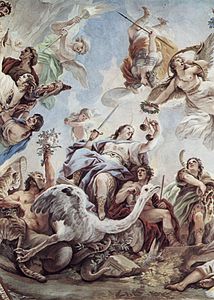
Luca Giordano, Palazzo Medici Riccardi in Florence, 1684–1686
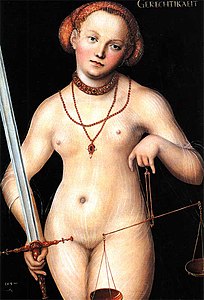
Gerechtigkeit, Lucas Cranach the Elder, 1537
Heraldry[]
Lady Justice and her symbols are used in heraldry, especially in the arms of legal government agencies.
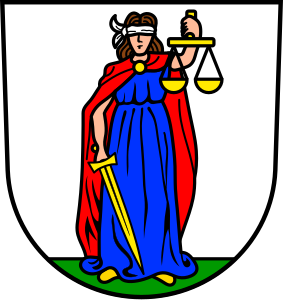
Justitia in arms of Ilshofen in Baden-Württemberg
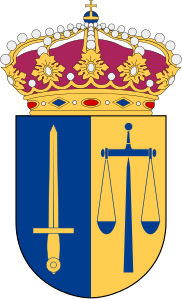
Scales and sword in the arms of a Swedish court of law

Scales balanced on a sword in the arms of Hörby
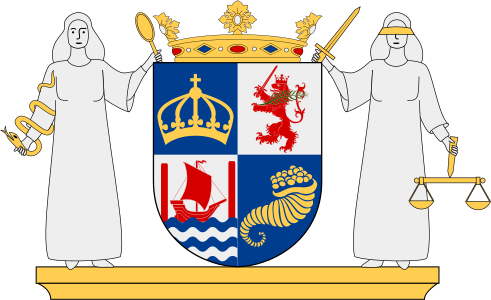
Prudentia and Justitia as supporters in the armorial achievement of Landskrona
- Justice in numismatics

Justice holding scales, $0.50 U.S. fractional currency.
See also[]
[]
- (Goddesses of Justice): Astraea, Dike, Themis, Eunomia, Prudentia, Praxidice
- (Goddesses of Injustice): Adikia
- (Aspects of Justice):
- (Justice) Themis/Dike/Eunomia/Justitia (Lady Justice), Raguel (the Angel of Justice)
- (Retribution) Nemesis/Rhamnousia/Rhamnusia/Adrasteia/Adrestia/Invidia
- (Redemption) Eleos/Soteria/Clementia, Zadkiel/Zachariel (the Angel of Mercy)
- Durga, Hindu goddess of justice
- Lady Luck
- Lady Liberty
Astronomy[]
- 5 Astraea, 24 Themis, 99 Dike and 269 Justitia, main belt asteroids all named for Astraea, Themis, Dike and Justitia, Classical goddesses of justice.
Notable programs[]
- "Operation Lady Justice (Presidential Task Force on Missing and Murdered American Indians and Alaska Natives)
Female justices of the US Supreme Court[]
Female justices of the UK Supreme Court[]
- Brenda Hale, Baroness Hale of Richmond
- Jill Black, Lady Black of Derwent
- Mary Arden, Lady Arden of Heswall
- Vivien Rose, Lady Rose of Colmworth
In fiction[]
- Judge Anderson, a female fictional law enforcer and psychic appearing in the British science fiction comics 2000 AD and the Judge Dredd Megazine.
References[]
- ^ Hamilton, Marci. God vs. the Gavel, page 296 (Cambridge University Press 2005): "The symbol of the judicial system, seen in courtrooms throughout the United States, is blindfolded Lady Justice."
- ^ Fabri, The challenge of change for judicial systems, page 137 (IOS Press 2000): "the judicial system is intended to be apolitical, its symbol being that of a blindfolded Lady Justice holding a balanced scales."
- ^ Jump up to: a b c "IUSTITIA". treccani.it.
- ^ "Apendix D: Legal Symbols of the Anglo-American Legal Tradition". The Guide to American Law : Everyone's Legal Encyclopedia. 11. West Publishing Company. St. Paul [Minn.]: West Pub. Co. 1983. p. 687. ISBN 0314732241. OCLC 9196541.CS1 maint: others (link)
- ^ See "The Scales of Justice as Represented in Engravings, Emblems, Reliefs and Sculptures of Early Modern Europe" in G. Lamoine, ed., Images et representations de la justice du XVie au XIXe siècle (Toulouse: University of Toulose-Le Mirail, 1983)" at page 8.
- ^ Image of Lady Justice in Berne.
- ^ Image of Lady Justice in London.
- ^ Colomb, Gregory. Designs on Truth, p. 50 (Penn State Press, 1992).
- ^ Image of Lady Justice in Memphis.
- ^ Jump up to: a b Brent T. Edwards. "Symbolism of Lady Justice". Retrieved 24 February 2017.
- ^ "Unicode Data-4.1.0". Retrieved 2020-09-28.
- ^ Takács, Peter. "Statues of Lady Justice in Hungary: Representation of Justitia in town halls, courthouses, and other public spaces" (PDF). Győr, Hungary: Széchenyi István University. ISSN 1335-3608. Cite journal requires
|journal=(help)
External links[]
| Wikimedia Commons has media related to Iustitia. |
- DOJ Seal - History and Motto[dead link]
- Justice goddesses
- Personifications in Roman mythology
- Roman goddesses
- Heraldic charges














